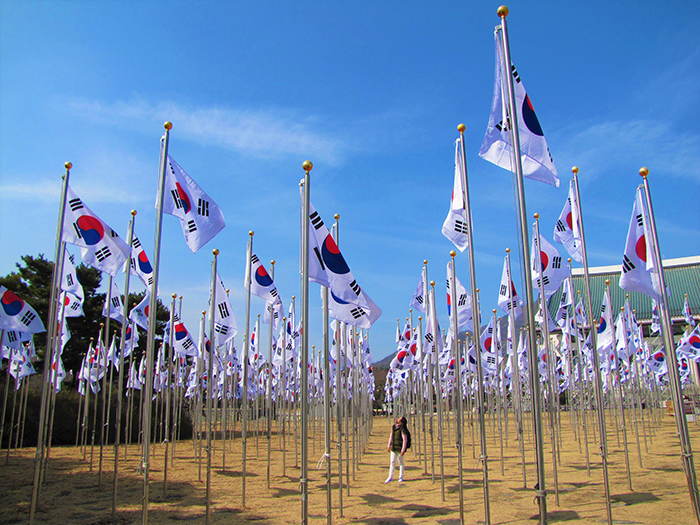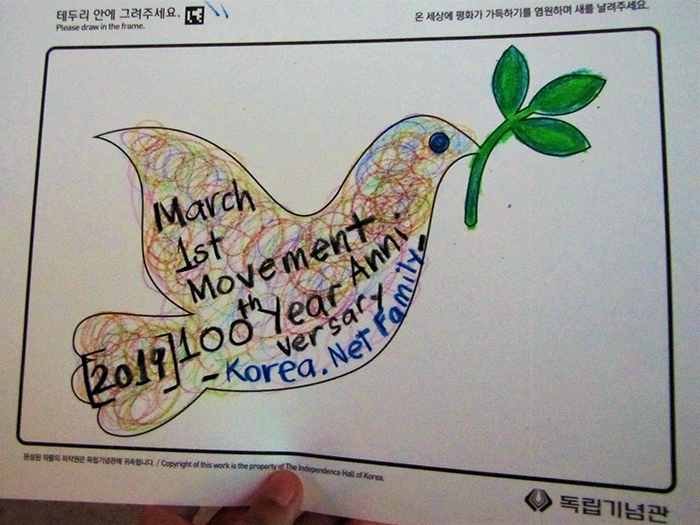View this article in another language
- 한국어
- English
- 日本語
- 中文
- العربية
- Español
- Français
- Deutsch
- Pусский
- Tiếng Việt
- Indonesian

Taegeukgi Garden at Independence Hall of Korea in Cheonan, Chungcheongnam-do Province.
By Korea.net Honorary Reporter Lalien Guillen Park from the Philippines
Photos = Lalien Guillen Park
This year marks the centennial anniversary of the March First Independence Movement, known in Korea as Samiljeol. What is this holiday about, what inspired it and how significant is it? Here are facts and insights about what I consider the most influential rally during Korea’s 35 years of Japanese colonial rule.
What happened during the movement?
After nearly a decade of oppressive Japanese occupation, Koreans’ desire to regain their sovereignty reached its tipping point in early 1919. On Feb. 26, young independence activists drafted the Korean declaration of independence. By midnight the next day, 21,000 copies of it were printed and distributed to regions throughout the country at the dawn of March 1 including Pyeongyang, Wonsan, Daegu, Gunsan, Imsil and Seoul. The protests were intended to be peaceful demonstrations where delegates would read the declaration from designated places at 2 p.m. But carried away by nationalistic fervor after listening to the proclamation, people attending the rallies grew rowdy as they repeatedly shouted “Manse (Hurrah)!” Violence then broke out as Japanese police attempted to suppress them, and many protesters were beaten and arrested.
What inspired the movement?
The Fourteen Points presented by U.S. President Woodrow Wilson at the Paris Peace Conference on Jan. 8, 1919, heavily inspired the movement. This set of peace principles was used for negotiations to end World War I. The fifth principle, self-determination, was described as the following:
"A free, open-minded, and absolutely impartial adjustment of all colonial clams, based upon a strict observance of the principle that in determining all such questions of sovereignty the interests if the populations concerned must have equal weight with the equitable claims of the government whose title is to be determined."
In response to the Fourteen Points, members of the Korean Youth Independence Corps in Tokyo secretly held meetings and drafted in Japanese a petition urging a national congress. They also drafted a declaration of independence and a resolution in Korean, Japanese and English. One member named Song Kye-baek was sent to Korea along with the drafts and the message that Korean students in Japan would declare independence on Feb. 8 by sending copies of the petitions and declarations to Japanese cabinet members, the Japanese governor-general of Korea, newspapers and selected scholars. This prompted independence leaders in Korea to also organize a movement on March, 1, 1919.
How significant was the movement?
To me, the movement was the most influential rally during Japanese occupation of Korea. Though it failed to result in the independence the Korean people wanted so badly at that time, the movement solidified a sense of patriotism in everyone. It united them as a nation to demonstrate their resentment over foreign occupation and burning desire for sovereignty and independence. This movement didn’t end that day, as 1,500 more mass demonstrations broke out over the next 12 months with participation by an estimated two million Koreans. The movement was like a fire that lit the heart of every Korean with patriotic fervor. Once lit, it spread like wildfire that was difficult to put out. The Korean fight for independence continued until the country’s eventual liberation in 1945. A hundred years might have passed but the patriotism ignited in the hearts of Koreans on March 1, 1919, will remain ablaze for generations to come.
I love how Koreans refer to their nation as uri nara (our country). Though other terms can be used, every Korean regardless of age and from all walks of life uses uri nara when referring to Korea. I see it as a reflection of Koreans being united in loving their country. And as long as they keep using that term, I believe patriotism will keep burning within all Koreans for more than ten thousand years.

The March First Independence Movement this year marks its centennial anniversary.
wisdom117@korea.kr
* This article is written by a Korea.net Honorary Reporter. Our group of Honorary Reporters are from all around the world, and they share with Korea.net their love and passion for all things Korean.